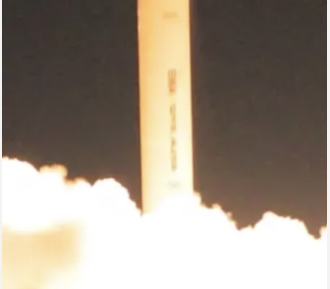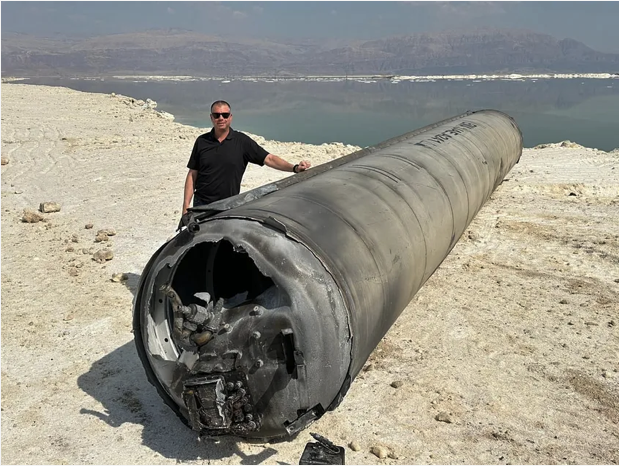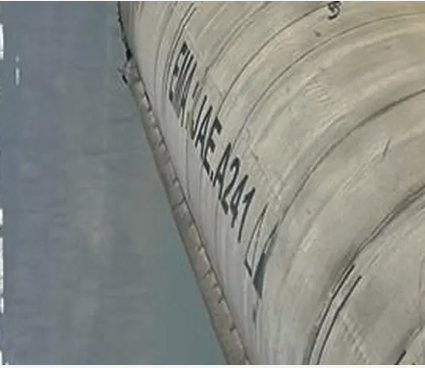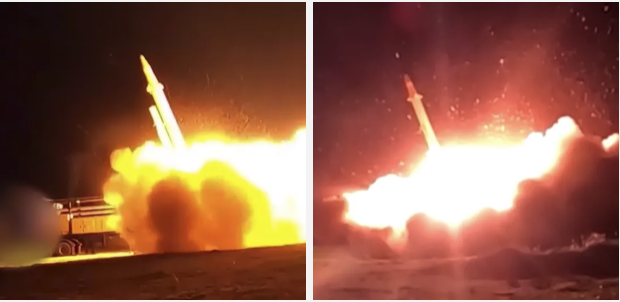Iran Breaches Anglo-Zionist Defenses in Historic Attack: A Breakdown

 Simplicius
Simplicius
Resize text-+= |
Iran made history yesterday by launching “Operation True Promise”. In our usual style here, let’s cut through all the noise currently clogging up social networks and incisively demonstrate the facts as thoroughly as possible, while also pointing out how this was a game-changing and historic event which has brought Iran onto the world stage in a big way.
Firstly, as establishment, Iran’s stated goal for the operation was to strike back at the bases from which the Israeli consular attack was launched on April 1:
IRGC has listed its objectives for last nights missile attack: Ramon and Nevatim airbases (where attack on Iran Consulate was conducted from). Israeli Air Force intelligence HQ in Tel Aviv (where attack on Iran Consulate was planned) and degrading of Israeli air defence radars and assets.
The footage is of the Intelligence HQ getting hit. I have yet to see evidence of 99% interception. Ramon has been badly hit. Nevatim was hit by more than 7 missiles. Air Force Intelligence HQ completely leveled. Other strikes on air defence installations obviously not close to population centres and out of view but I'm sure sat intel will show extent of damage.
And another:
➖Nevatim Airbase in the south of occupied Palestine
➖Ramon Airbase in the south of occupied Palestine
➖The Israeli top-secret intelligence-spy base in Jabal al-Sheikh (Mount Hermon) in the north of the occupied Golan
It should be noted that the rest of the explosions or hits in other areas of the occupied territories are related to the confrontation of the Israeli air defense systems with the projectiles in the sky or the falling of the wreckage of the interceptor missiles or the wreckage of Iranian missiles.
Now, let’s get down to the nuts and bolts.
This strike was unprecedented for several important reasons. Firstly, it was of course the first Iranian strike on Israeli soil directly from Iranian soil itself, rather than utilizing proxies from Iraq, Syria, Lebanon, Yemen, etc. This alone was a big watershed milestone that has opened up all sorts of potentials for escalation.
Secondly, it was one of the most advanced and longest range peer-to-peer style exchanges in history. Even in Russia, where I have noted we’ve seen the first ever truly modern near-peer conflict, with unprecedented scenes never before witnessed like when highly advanced NATO Storm Shadow missiles flew to Crimea while literally in the same moments, advanced Russian Kalibrs flew past them in the opposite direction—such an exchange has never been witnessed before, as we’ve become accustomed to watching NATO pound on weaker, unarmed opponents over the last few decades. But no, last night Iran upped the ante even more. Because even in Russia, such exchanges at least happen directly over the Russian border onto its neighbor, where logistics and ISR is for obvious reasons much simpler.
But Iran did something unprecedented. They conducted the first ever modern, potentially hypersonic, assault on an enemy with SRBMs and MRBMs across a vast multi-domain space covering several countries and timezones, and potentially as much as 1200-2000km.
Additionally, Iran did all this with potentially hypersonic weapons, which peeled back another layer of sophistication that included such things as possible endoatmospheric interception attempts with Israeli Arrow-3 ABM missiles.
But let’s step back for a moment to state that Iran’s operation in general was modeled after the sophisticated paradigm set by Russia in Ukraine: it began with the launch of various types of drones, which included some Shahed-136s (Geran-2 in Russia) as well as others. We can see that from the Israeli-released footage of some of the drone interceptions:
At the 0:49 mark you can see what looks like a Shahed, though it appears similar to the jet-engine-equipped Shahed-238 variety.
After a certain pre-timed span, Iran then released cruise missiles so that they could strike roughly in a similar window as the drones. One video from last night confirmed the low-flying cruise missile presence:
It’s not known for certain, but it appears it could be the new Abu Mahdi missile which has the appropriate ~1000km range. Here’s some other possibilities:
Then, following the appropriate time interval, Iran launched the coup de grace, its vaunted ballistic missiles. Here’s Iran’s own released footage of the start of Operation True Promise, which includes the ballistic launches:
As stated, all three layers of the attack were timed to coincide, with the slowest (drones) going first, then next fastest (cruise missiles), followed by the fastest time-to-target, the ballistic missiles.
The U.S. scrambled a large coalition to shoot the threats down, which included the U.S. itself, UK flying from Cyprus, France, and, controversially, Jordan which allowed them all to also use its airspace and even partook in the shoot-downs.
Dozens of images proclaimed the “successful” shoot-downs of Iranian ballistic missiles, like the following:
The problem is, all of those are the ejected booster stages of two-stage rockets. There is no conclusive proof that any ballistic missiles were shot down, and in fact all the evidence points to the opposite: direct footage of the missiles penetrating the AD net and striking targets. But we’ll get to that.
Missile Types
First: what kinds of ballistic missiles did Iran use?
There are speculations and then there’s what can be dutifully confirmed.
As for the confirmed, with my own eyes from the actual longer released launch video we can see the following:
Which appears to match what is likely the Shahab-3 below:
Here’s another photo from a Shahab-3 test:
In the launch photo, the very top warhead nose cone does appear slightly shorter and may match the Sejjil rocket better. The Sejjil is in fact a much newer evolution of and upgrade to the Shahab that has both a two-stage and three-stage variety for an extremely long range of 2500km+. And some also claim it might be the Ghadr-110, but this is also an evolution and similar ‘upgrade’ of the Shahab-3 system, which likewise looks almost identical.
There are some other launch videos that appear to show possible Zolfagher or the updated Dezful systems as well.
Then there is the closest shot of the launch video, which gives us the most accurate confirmation of one of the missile types:
On the fuselage you can see what appears to be EMA written, and the same can be seen on this photo from today of a “downed missile” somewhere in Iraq:
This comes closest to confirming that missile to be an Emad from the chart above, which is one of Iran’s most advanced and can feature a MaRV (Maneuverable Re-entry Vehicle) warhead. This is where it starts getting interesting, because the hits we saw in Israel appeared to potentially utilize some form of MaRV or hypersonic glide vehicle, which would mean Iran could have made history even beyond what we thought.
So let’s get there by first mentioning the other controversial claim that Iran possibly used its most advanced new hypersonic Fattah-2 system:
In none of the launch videos was this visible, but that doesn’t necessarily preclude Iran having secretly launched and tested some of the above. An Iranian academic stated the following:
"Iran has not fired its hypersonic missiles. In fact, most of the drones and missiles that were fired were older drones and missiles. They were very inexpensive and were used as decoys. So Iran spent a couple of million dollars to force the Israelis to spend $1.3 billion in anti-missile missiles, which was itself a big achievement by the Iranians. And then a number of other missiles that the Iranians fired...cut through and struck their targets," the academic and geopolitical affairs commentator told Sputnik.
And lastly, there are some experts who believe Iran utilized its elusive hypersonic Kheybar Shekan missile, which also features a highly maneuverable MaRV.
These are two shots from last night’s launch video:
And here is a stock photo of the Kheybar nosecone and warhead:
This is where it gets most interesting, and why I’ve prefaced it so thoroughly.
In short: while Israel and the U.S. claim they shot down 100% of everything, and while it’s possible that the drone and cruise missile lures were mostly shot down—though we have no strong evidence one way or the other—we do have evidence that the ballistic missiles largely went unopposed, slicing through what’s claimed to be the densest air defense in the world. Not only Israel’s itself, comprised of a layered defense of David Slings, Arrow-3s, Patriots, and Iron Dome, but also the aforementioned allied airforces, as well as what’s now been reported to be a U.S. Arleigh Burke warship firing upwards of 70+ SM-3 missiles from the Mediterranean shore.
The hits that we saw were spectacular in one profound way: the terminal velocity of the Iranian ballistic missiles appeared stunningly fast. Let’s review some of the most exemplary videos.
Here’s by far the most revealing one, which totally refutes Israeli claims of 100% shoot downs. Note the massive swarm of air-defense missiles going up at the onset, then at the middle mark, watch as Iranian ballistics crash through the AD net totally unopposed at high speed, slamming into the ground:
As a quick aside, this next video was claimed by many to show Israeli Arrow-3 missiles shooting down Iranian ballistics in the exoatmosphere, i.e. in space:
But in reality, all it shows is the stage separation of the Arrow missiles as they climb toward the exoatmospheric zone. It does not show any actual successful interceptions, nor is there any evidence of a single ballistic missile being shot down.
But here’s where we get down to business. The next video is the most eye-opening in terms of the capabilities of these missiles. The two most important things to note are: 1) the terminal velocity right before impact and 2) note how some of the missiles strike very precisely onto the same location in groups.
First video, note the terminal speed here:
SIDEBAR (by TGP editor)
A video published by CNN —News 18 (Indian channel) confirms the sophistication of the Iranian attack.
Israel Vs Iran War | Iran Launches Missile, Drone Attacks LIVE | Israel Iran LIVE News | Iran News
Israel Vs Iran War | Iran Launches Missile, Drone Attacks LIVE | Israel Iran LIVE News | Iran News Iran has launched dozens of drones and missiles at Israel, the country’s Islamic Revolutionary Guard Corps (IRGC) confirmed, after Israel said Tehran had begun attacks. The IRGC said on Saturday that it had released the drones and missiles under the operation “True Promise”, adding that the move was part of the punishment for “Israeli crimes”.
News 2739
- If you approve of this article, please share it with your friends and kin.
- Help us expand our reach. Defeat appalling hypocrisy. Lies cost countless lives.
- We must act together to smash the VILE Western disinformation machine.
- This is the Lying Machine that protects the greatest evil humanity has ever seen.
- YOU know what we are talking about.
- If you approve of this article, please share it with your friends and kin.
- Help us expand our reach. Defeat appalling hypocrisy. Lies cost countless lives.
- We must act together to smash the VILE Western disinformation machine.
- This is the Lying Machine that protects the greatest evil humanity has ever seen.
- YOU know what we are talking about.
Neo-Nazi ideology has become one of the main protagonists of political and social life in Ukraine since the 2014 coup d'état. And that's a fact.
No Comment
Print this article
The views expressed herein are solely those of the author and may or may not reflect those of The Greanville Post. However, we do think they are important enough to be transmitted to a wider audience.
Since the overpaid media shills will never risk their careers to report the truth, the world must rely on citizen journalists to provide the facts that explain reality.
Unfortunately, most people take this site for granted.
DONATIONS HAVE ALMOST DRIED UP…
PLEASE send what you can today!
JUST USE THE BUTTON BELOW

This work is licensed under a Creative Commons Attribution-NonCommercial 4.0 International License

















